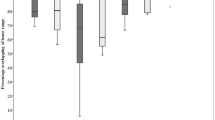Summary
From 1976 to 1978, ten female red deer in the northern parts of the Bavarian Alps (Southern West Germany) were fitted with transmitter collars. Seasonal movements, the home range patterns, and habitat utilization as a function of the habitat structure were examined. While some animals remained in the lowlands throughout the year, others move between two or even three different areas seasonally. The average size of the home range was 65 ha during winter, 167 ha in spring and autumn and 121 ha in summer. The overlap of home ranges of different individuals ranged from 18 to 100%. In habitats with a patchy vegetation structure the home ranges were used more uniformly, whereas in habitats with a distinct separation of large woods and meadows home ranges show diurnal and nocturnal activity centres respectively.
Similar content being viewed by others
References
Atzler R (1978) Schwankungen der Qualität der Bodenvegetation während der Vegetationszeit im Rothirschuntersuchungsgebiet Ammergauer Berge. Diplomarbeit, München, p 155
Bertram RC, Rempel RD (1977) Migration of the North Kings Deer Herd. Calif Fish and Game 63:157–179
Blankenhorn HJ, Buchli Ch, Voser P (1978) Wanderungen und jahreszeitliche Verteilungsmuster der Rothirschpopulationen (Cervus elaphus L.) im Engandin, Münstertal und Schweizerischen Nationalpark. Revue Suisse Zool 85:779–789
Burt WH (1943) Territoriality and home range concepts as applied to mammals. J Mammal 24:346–352
Craighead JJ, Craighead FC, Ruff RL, O'Gara BW (1973) Home ranges and activity patterns of nonmigratory elk of the Madison Drainage Herd as determined by biotelemetry. Wildl Monographs 33, p 50
Darling FF (1937) A herd of red deer. Oxford University Press, London, p 226
Dasmann RF, Taber RD (1956) Behavior of Columbian black-tailed deer with reference to population ecology. J Mammal 37:143–164
Drolet ChA (1976) Distribution and movements of white-tailed deer in southern New Brunswick in relation to environmental factors. Canadian Field-Naturalist 90:123–136
Feldner R (1978) Waldgesellschaften, Wald- und Forstgeschichte und Schlußfolgerungen für die waldbauliche Planung im Naturschutzgebiet Ammergauer Berge. Dissertation, Wien
Franklin WL, Mossman AS, Dole M (1975) Social organization and home range of Rossevelt Elk. J Mammal 56:102–118
Geist V (1968) Welchen Wert hat die Verhaltensforschung in Wildnisgebieten für eine moderne Verwaltung? Beiträge zur Jagd- und Wild-forschung VI:9–16
Geist V (1971) Tradition und Arterhaltung bei Wildschaf und Elch. Naturwissenschaft und Medizin 8:25–35
Geist V (1977) Adaptive strategies in the behaviour of elk. In: The Ecology and Management of the North American Elk, ed JW Thomas. Washington DC: Wildlife Management Institute. In press
Georgii B Activity patterns of female red deer in the alps. Oecologia (Berl) in press
Hayne DW (1949) Calculation of size of home range. J Mammal 30:1–17
Heezen K, Tester JR (1967) Evaluation of radio tracking by triangulation with special reference to deer movements. J Wildl Manage 31:124–141
Hediger H (1950) Wild animals in captivity. London Butterworth, p 152
Jewell PA (1966) The concept of home range in mammals. Symp Zool Soc Lond 18:85–109
Kalela O (1961) Wanderungen. Handbuch der Zoologie 8:27/1–39
Kobell F v (1859) Wildanger. JG Cotta'scher Verlag, Stuttgart, p 491
Lowe VPW (1966) Observations on the dispersal of red deer on Rhum. In: PA Jewell and C Loizos (ed) Play, Exploration and Territory in Mammals. Academic Press, London and New York, 211–228
Miller FL (1970) Distribution patterns of black-tailed deer (Odocoileus hemionus columbianus) in relation to environment. J Mammal 51:248–259
Mitchell B, Staines BW, Welch D (1977) Ecology of red deer. Institute of Terrestrial Ecology, Cambridge, p 74
Moen AN (1973) Wildlife Ecology. Freeman and Company, San Francisco, p 458
Moen AN (1976) Energy conservation by white-tailed deer in the winter. Ecology 57:192–198
Nievergelt B (1966) Der Alpensteinbock in seinem Lebensraum. Mammalia depicta 1:p 86
Odum EP, Kuenzler EJ (1955) Measurement of territory and home range size in birds. Auk 72:128–137
Phillips RL, Berg WE, Siniff DB (1973) Moose movement patterns and range use in northwestern Minnesota. J Wildl Manage 37:266–278
Robin K (1975) Räumliehe Verschiebungen von markierten Rehen (Capreolus capreolus L.) in einem voralpinen Gebiet der Ostschweiz. Z Jagdwiss 21:145–163
Robinette WL (1966) Mule deer home range and dispersal in Utah. J Wildl Manage 30:335–349
Schröder W (1978) Der Rothirsch. Jahrbuch des Vereins zum Schutze der Bergwelt 43:123–150
Sonnenberger H, Georgii B, Schröder W, Freimann D (1977) Ein System zur Funkortung und automatischen Aufzeichnung der Aktivität von wildlebenden Huftieren. Z Jagdwiss 23:137–143
Sparrowe RD, Springer PF (1970) Seasonal activity patterns of whitetailed deer in eastern South Dakota. J Wildl Manage 34:420–431
Staines BW (1970) The management and dispersion of a red deer population in Glen Dye, Kircadineshire. Ph D Thesis University of Aberdeen
Stardom RRP (1975) Woodland caribou and snow conditions in southeast Manitoba. Proc Ist Int Reindeer and Caribou Symp Fairbanks, Alaska
Stevens DR (1970) Winter ecology of moose in the Gallatin Mountains, Montana. J Wildl Manage 34:37–46
Telfer ES (1970) Winter habitat selection by moose and white-tailed deer. J Wildl Manage 34:553–559
Wallmo OC, Gill RB (1971) Snow, winter distribution, and population dynamics of mule deer in the central Rocky Mountains. Snow and Ice Symposium, 1–15. Iowa Cooperative Wildlife Research Unit, Ames, Iowa
Wauer A (1979) Deckung und Nahrung in einem Aktivitätszentrum von Rothirschen in den Ammergauer Bergen. Diplomarbeit, Universität München, p 106
Wiesner H (1977) Narkosepraxis mit dem Blasrohrgewehr. Kleintierpraxis 22:327–330
Winkle W van (1975) Comparison of several probalistic home range models. J Wildl Manage 39:118–123
Author information
Authors and Affiliations
Rights and permissions
About this article
Cite this article
Georgii, B. Home range patterns of female red deer (Cervus elaphus L.) in the Alps. Oecologia 47, 278–285 (1980). https://doi.org/10.1007/BF00346833
Received:
Issue Date:
DOI: https://doi.org/10.1007/BF00346833




